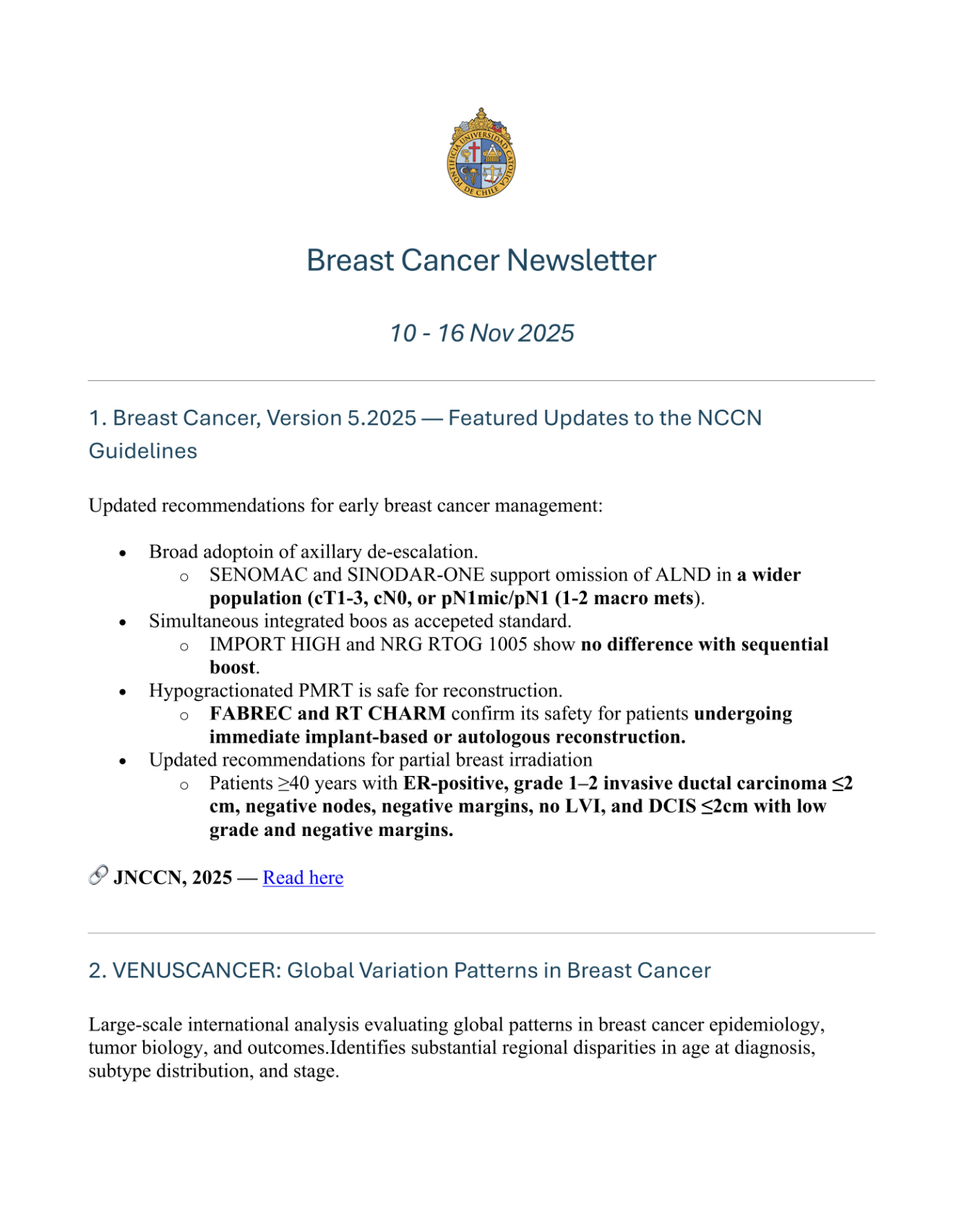Benjamin Walbaum, Medical Oncologist at Pontifical Catholic University of Chile, shared a post on LinkedIn:
“Breast Cancer Weekly Highlights | November 10–16, 2025
My personal selection of last week’s most interesting and relevant data, spanning guidelines, global disparities, ADC resistance, tumor ecosystem dynamics, the microenvironment, and cardiotoxicity.
1. NCCN Breast Cancer Guidelines v5.2025 — Key Updates
Broader adoption of axillary de-escalation (SENOMAC, SINODAR-ONE) for cT1–3 cN0 or pN1 (1–2 macromets).
Simultaneous integrated boost now accepted standard (IMPORT-HIGH, NRG 1005).
Hypofractionated PMRT safe with immediate reconstruction (FABREC, RT-CHARM).
Refined indications for partial breast RT (≥40 y, ER+, G1–2, ≤2 cm, negative nodes/margins).
JNCCN
2. VENUSCANCER Global Patterns in Breast Cancer
Large-scale international analysis showing wide disparities in stage, subtype distribution, and access to surgery.
Time from diagnosis to surgery ranged from <1 month in HICs to 4 months in Colombia and 12 months in Mongolia.
Highlights structural inequities affecting early-stage outcomes in LMICs.
Lancet Oncology
3. Mechanisms of T-DXd Resistance
Paired biopsies (n=102) show HER2 loss in ~50% of progressing tumors.
Novel ERBB2-binding domain mutations (V597M, P593R) disrupt trastuzumab interaction.
Reduced HER2 expression impairs T-DXd internalization.
HER2 + TROP2 ADC combinations restored DXd delivery in preclinical models.
Cancer Discovery
4. Neoadjuvant Chemotherapy Dose Intensity (HER2-Negative)
Multicenter cohort (n=365).
TNBC: RDI ≥85% strongly associated with pCR (OR 3.1) and EFS.
HR+/HER2–: Higher RDI improved EFS in multivariate analysis.
Reinforces the importance of avoiding dose reductions/delays in NACT.
European Journal of Cancer
5. Longitudinal Tumor–Immune Ecosystem Dynamics
scRNA-seq at 4 timepoints in an immunocompetent model.
Tumor ecosystems evolve in a predictable sequence as tumors enlarge.
Macrophages differentiate into four archetypes; one expands to support immune evasion.
T cells and innate lymphoid cells mount strong but transient responses.
Cell (iScience)
6. TME Ecotypes Across 14,837 Breast Cancers
Meta-analysis using InstaPrism.
7 microenvironmental ‘ecotypes’ with prognostic value independent of PAM50.
Within Luminal A/B, immune-rich vs. immune-poor and stromal-high vs. stromal-low patterns stratify survival.
B-cell depletion more frequent in metastases.
Cell Reports Medicine
7. Cardiotoxicity of ADCs vs Standard Anti-HER2 Therapy
Systematic review & meta-analysis (n=9,538).
T-DM1: Lowest LVEF decline (0.94%).
T-DXd and trastuzumab ± pertuzumab show similar rates (~4–6%).
Supports excellent cardiac safety of T-DM1 and the need for monitoring with T-DXd.
JAMA Network Open
Bonus: When Is Enough Enough? — Long-Term Therapy Decision Making
Editorial examining when to safely discontinue long-term targeted therapy in exceptional responders.
Discusses balancing efficacy, toxicity, and quality of life in modern chronic oncology care.
Journal of Clinical Oncology.”

More posts featuring Benjamin Walbaum.
